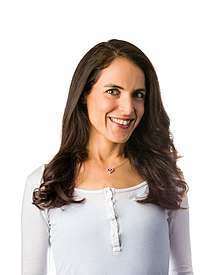Yael Tauman Kalai
Yael Tauman Kalai is a cryptographer and theoretical computer scientist who works as a Senior Principal Researcher at Microsoft Research New England[1][2] and as an Adjunct Professor at MIT in the Computer Science and Artificial Intelligence Lab.[3]
Yael Tauman Kalai | |
|---|---|
 | |
| Born | |
| Alma mater | Massachusetts Institute of Technology |
| Known for | Ring Signatures, the insecurity of the Fiat–Shamir heuristic, delegating computation |
| Scientific career | |
| Fields | Cryptography, Computer Science |
| Institutions | Massachusetts Institute of Technology, Microsoft Research |
| Doctoral advisor | Shafi Goldwasser |
Education and career
Kalai graduated from the Hebrew University of Jerusalem in 1997. She worked with Adi Shamir at the Weizmann Institute of Science, earning a master's degree there in 2001, and then moved to the Massachusetts Institute of Technology, where she completed her PhD in 2006 with Shafi Goldwasser as her doctoral advisor. She did postdoctoral study at Microsoft Research and the Weizmann Institute before becoming a faculty member at the Georgia Institute of Technology. She took a permanent position at Microsoft Research in 2008.[1][2]
Contributions
Kalai is known for co-inventing ring signatures, which has become a key component of numerous systems such as Cryptonote and Monero (cryptocurrency). Subsequently, together with her advisor Shafi Goldwasser, she demonstrated an insecurity in the widely used Fiat–Shamir heuristic. Her work on delegating computation has applications to cloud computing.[4]
Recognition
Kalai was an invited speaker on mathematical aspects of computer science at the 2018 International Congress of Mathematicians.[5]
Her master's thesis introducing ring signatures won an outstanding master's thesis award[2] and MIT PhD dissertation was awarded the George M. Sprowls Award for Outstanding PhD Thesis in Computer Science.[2][6]
She was co-chair of the Theory of Cryptography Conference in 2017.[7]
Personal
Kalai is the daughter of game theorist Yair Tauman. Her husband, Adam Tauman Kalai, also works at Microsoft Research.[8]
References
- Yael Tauman Kalai, Principal Researcher, Microsoft, retrieved 2018-09-11
- Yael Kalai, Researcher, Microsoft Research New England, Simons Institute for the Theory of Computing
- Yael Kalai, MIT CSAIL, Massachusetts Institute of Technology, September 10, 2018
- Hardesty, Larry (June 10, 2013), "Securing the cloud: New algorithm solves major problem with homomorphic encryption", MIT News, Massachusetts Institute of Technology, retrieved 2018-09-11 – via Phys.org
- "Invited section lectures", ICM 2018, retrieved 2018-08-08
- "Awards and Honors 2007", EECS Newsletter, Massachusetts Institute of Technology Department of Electrical Engineering and Computer Science, Fall 2007, retrieved Sep 10, 2018
- Theory of Cryptography: Proceedings of the 15th International Conference, TCC 2017, Baltimore, MD, USA, November 12-15, 2017, Springer, retrieved 2018-09-11
- Knies, Rob (May 14, 2009), New England Researcher Finds Her Bliss, Microsoft
External links
- Yael Tauman Kalai publications indexed by Google Scholar